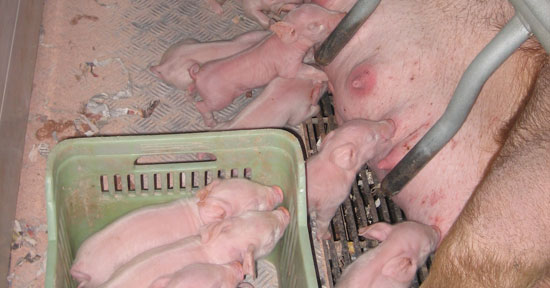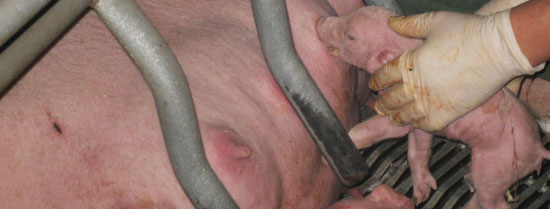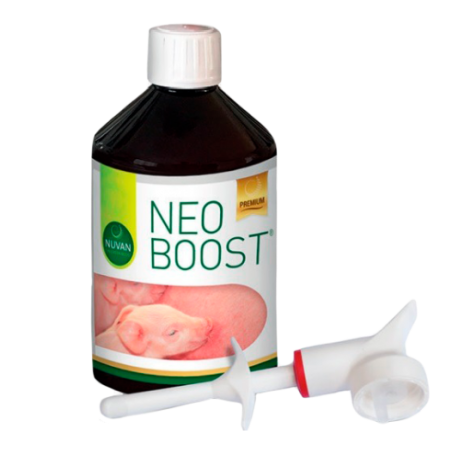In pigs there is no other phase in which such a high percentage of losses occur such as in farrowing site, in particular in the first days of life. At this stage the determining factor for survival is the rapid consumption of colostrum.
Table 1. Influence of colostrum intake in survival and immunity of piglets

| Colostrum intake | Pre-weaning mortality rate |
| < 200 grams | 43,4% |
| >200 grams | 7,1% |
N. Devillers-, J. Le Dividich and A. Prunier
Colostrum intake is essential for:
Energy needs: glycogen stores in a newborn piglet are very rare, therefore the colostrum is needed to maintain their body temperature and metabolism.
Acquire passive immunity: the epitheliochorial placenta of swine prevents placental transfer of antibodies. Thus the piglet, in the first weeks of life, is totally dependent on the specific and nonspecific immunity that it receives through the colostrum.
A piglet needs to consume 200 to 400 grams of colostrum, but this is not always easy to achieve: apart from the rapid loss of body temperature after birth and then the competition to reach a good nipple, one must take into account the sow’s colostrum production and its absorption by the piglet:
- Colostrum is only produced by the sow for 24-48 hours, and the IgG concentration decreases rapidly after birth.
- The piglet’s intestine’s capacity to absorb immunoglobulins is quickly reduced. Only 12 hours after birth it can only absorb 25% of the antibodies.
Therefore, ensuring a good intake of colostrum is a key to ensuring good production on farms. I like to define colostrum intake as a three-legged table; if one leg fails, the table will not stand up. The three essential legs for us to consider are:
- The sow’s milk capacity.
- The vitality of the piglets.
- Specific management of colostrum intake.
The aim of this article is not to go on about the first two "legs", but we mustn’t forget that we need to provide the conditions so that most piglets get enough colostrum alone and make the extra effort to make things easier for smaller and weaker piglets, in the case of large litters. So it would not make sense to take great pains regarding colostrum intake if we haven’t taken the time to, for example, dry the piglets after birth, maintain their temperature, or if we had sows with poor body condition at farrowing, something that impedes their colostrum production.
There are specific protocols in order to facilitate or directly provide colostrum to piglets that are weaker than others and will have a hard time obtaining it without assistance. On a farm we can perform different techniques:
Split nursing, or separate colostrum intake
Separate the larger piglets in the litter for 1.5 hours in another pen in order to allow smaller piglets to have access to colostrum without competition from their larger brothers.
Occasionally, when separating litters 2 errors are committed. This is what you need to avoid:

- Leaving a small number of smaller piglets out of the box that cannot sufficiently stimulate the udder and thus stimulate the production of colostrum (Fraser 1984). I always recommend leaving no less than 7 piglets.
- Piglets that are too weak: sometimes the split is too late or done with piglets that have a very low birth weight, that are cold and with no ability to reach the udder. In this case we need a more direct colostrum intake.

Assisted colostrum intake
The idea is to assist the pig in reaching the teat, then monitoring that is capable of feeding itself.

Direct colostrum intake
This allows us to directly provide colostrum to the piglets with low birth weight (<800 g), cold piglets, or those with low vitality. We obtain the colostrum by milking the sows that are giving birth, that just give birth or even before they give birth.

Courtesy of Carles Casanovas
It is best to use the colostrum right away, although we can keep it in the fridge for a few hours or even freeze it. Colostrum should be fed directly with a syringe without needle or teat into the mouth of the piglet. Two to three doses of 15-20 ml during the first hours after delivery are highly desirable. If we heat the colostrum in a water bath at about 30 °C we will facilitate the piglet swallowing it.
Direct and assisted colostrum intake is time consuming on the farm. My advice is to apply separate colostrum intake routinely and assist colostrum intake exclusively to those piglets with very low birth weight, or those that don’t not have enough stamina to reach the udder by themselves.






